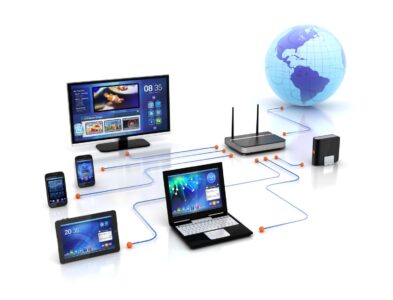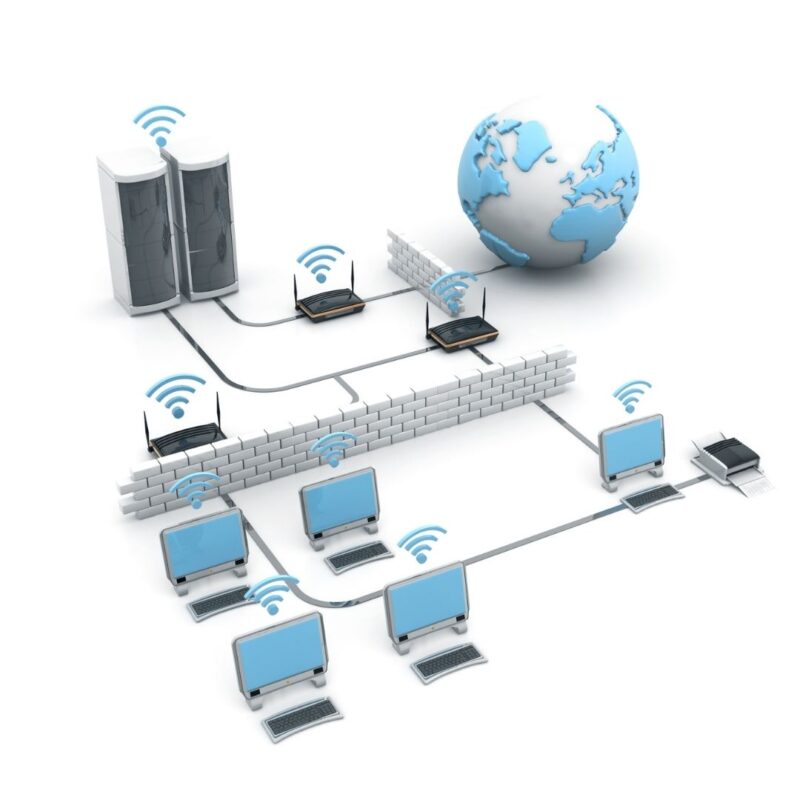
A computer network is a group of interconnected computers that are able to share resources and exchange data. Computers on a network can be located in the same room, in the same building, or in different parts of the world.
There are many different types of computer networks, including:
Local area networks (LANs): LANs are small networks that connect computers in a limited physical area, such as an office building or a home.
Wide area networks (WANs): WANs are large networks that connect computers over long distances, such as across cities or countries.
Metropolitan area networks (MANs): MANs are networks that connect computers in a city or metropolitan area.
Personal area networks (PANs): PANs are small networks that connect personal devices, such as computers, smartphones, and printers.
Computer networks use a variety of technologies to connect computers, including:
Cables: Cables are the most common type of network connection. They can be made of copper, fiber optic, or coaxial cable.
Wireless: Wireless networks use radio waves to transmit data between computers.
Satellite: Satellite networks use satellites to transmit data between computers.
Computer networks are essential for modern communication and collaboration. They allow us to share files, access resources, and communicate with each other in real time.
Here are some of the benefits of using computer networks:
Sharing resources: Computer networks allow us to share resources, such as printers, files, and applications. This can save us money and time.
Collaboration: Computer networks allow us to collaborate with others in real time. This can be helpful for working on projects, brainstorming ideas, and sharing information.
Communication: Computer networks allow us to communicate with others in real time, regardless of their location. This can be helpful for staying in touch with friends and family, conducting business, and providing customer service.
Access to information: Computer networks give us access to a vast amount of information. This information can be used for research, education, and entertainment.
Computer networks are an essential part of our lives. They have made it possible for us to communicate, collaborate, and access information more easily than ever before.
Troubleshooting:
There are many different types of computer network complaints that users may have. Here are some of the most common:
Slow network speed: This is one of the most common complaints about computer networks. It can be frustrating when a network is slow, especially when you’re trying to do something important, like download a file or stream a video.
Weak Wi-Fi signal: If you’re using a wireless network, you may experience weak signal strength in certain areas of your home or office. This can make it difficult to connect to the internet or use other network resources.
Physical connectivity issues: If a network cable is damaged or loose, it can cause problems with network connectivity. This can manifest itself in a variety of ways, such as slow speeds, dropped connections, or no connection at all.
Malfunctioning devices or equipment: If a network device, such as a router or switch, is malfunctioning, it can cause problems with network performance. This can be difficult to troubleshoot, as it can be hard to identify the specific device that is causing the problem.
DNS issues: DNS (Domain Name System) is a service that translates domain names into IP addresses. If there are problems with DNS, it can cause problems with accessing websites and other online resources.
Interference in the wireless network: If there is a lot of interference from other wireless devices, such as microwaves or cordless phones, it can cause problems with the Wi-Fi network. This can manifest itself in the form of slow speeds, dropped connections, or no connection at all.
Network congestion: If there is a lot of traffic on a network, it can cause congestion and slow down performance for everyone on the network. This is especially common during peak times, such as when everyone is trying to use the internet at the same time.
Packet loss: Packet loss occurs when data packets are lost during transmission over a network. This can cause problems with network performance, such as slow speeds, dropped connections, or no connection at all.
Jitter: Jitter is a measure of the variation in the time it takes for data packets to travel over a network. Excessive jitter can cause problems with network performance, such as slow speeds, dropped connections, or audio and video that is choppy or out of sync.
If you are experiencing any of these problems with your computer network, it is important to contact your IT department or network administrator for help. They will be able to diagnose the problem and take steps to fix it.
Resolution:
In computer networking, name resolution is the process of converting a human-readable computer name into a machine-readable network address, such as an IP address. This is necessary so that computers can communicate with each other on a network.
There are two main types of name resolution:
Static name resolution: This is the process of manually mapping computer names to IP addresses. This is typically done in small networks, where the number of computers is relatively small and the IP addresses are static.
Dynamic name resolution: This is the process of automatically mapping computer names to IP addresses. This is typically done in large networks, where the number of computers is large and the IP addresses are dynamic.
There are several different name resolution protocols that can be used, including:
Domain Name System (DNS): This is the most common name resolution protocol. DNS uses a distributed database of domain names and IP addresses to resolve names into addresses.
NetBIOS over TCP/IP (NetBIOS over IP): This is a legacy name resolution protocol that is still used in some networks. NetBIOS over IP uses broadcast messages to resolve names into addresses.
Windows Internet Name Service (WINS): This is a legacy name resolution protocol that is used in Windows networks. WINS uses a centralized database of computer names and IP addresses to resolve names into addresses.
Name resolution is an essential part of computer networking. Without name resolution, computers would not be able to communicate with each other on a network.
Here are some common problems with computer network resolving:
Incorrect IP address: If the IP address for a computer is incorrect, it will not be able to resolve the name of that computer.
Incorrect DNS server: If the DNS server is incorrect, it will not be able to resolve the names of computers on the network.
Network congestion: If the network is congested, it can slow down name resolution.
Name server failure: If the name server fails, it will not be able to resolve names on the network.
If you are experiencing problems with computer network resolving, you can try the following:
Check the IP address: Make sure that the IP address for the computer is correct.
Check the DNS server: Make sure that the DNS server is correct.
Try a different DNS server: If you are using a public DNS server, try using a different one.
Restart the computer: Restarting the computer can sometimes fix name resolution problems.
Contact Us: If you are still having problems, PC Lap Mall for help.

